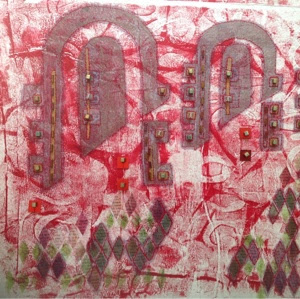PVA Resist is a technique that I guess is best described as batik without the wax.
Again, I found the technique described in Sew Wild, the book Daughter had bought me for my birthday.
Basically you apply PVA glue to fabric in the way that you would apply a hot wax - to act as a resist to a dye or a paint. I applied the glue by decanting it into a much smaller bottle with a very fine hole to control the flow of the glue onto the fabric.
I also kept the glue warm to make it flow more easily. I had a pan of warm water on the stove and heated the glue up by heating the water when it began to flow less smoothly (so like wax you do need to keep it warm, but it does not set so quickly).
It was also surprisingly hard work to apply the glue - by the end of a solid 2 hour session to apply the glue to these two pieces of fabric my shoulder was stiff and my hand ached a bit - from squeezing the bottle of glue.
But I found it much easier to control the flow of the PVA than when I used hot wax a couple of years ago. (The wax I found particularly frustrating as it flowed too quickly to start with and the design got a bit messy.)
Of course the flip side to this is that I had to leave the fabric to dry over night! (The wax dries almost instantly).
Then when it had dried I applied Dy Na Flow paints liberally with a soft brush.
On this sample you can see the PVA resist with the paint colouring the fabric, but also colouring the glue.
It is even more obvious on this sample. The rings are the glue and the paint has dried on the glue in a 'darker' way than on the fabric.
The down side of this technique is removing the glue! I am very glad I used Dy Na Flow paint. It sets really well and is very resistant to washing - and good job too since I had to wash it in very hot water, and then scrub the cloth on a board with the rough side of a scouring pad. As with all resist techniques - removing the resist is a challenge.
I like the finished results, but would I recommend it? Well, yes, but only if you can find a PVA glue that washes out more easily than the one I used!
Here are the finished pieces of cloth - again ready for a bit of over printing, as this is part of the City and Guilds course (you can see that the washing has faded the paint slightly, though in practice it is not as obvious as it would appear in the photographs).
 |
| Painted with Salmon and Chartreuse |
 |
| Painted with Ochre |
I like these cloths - the finished pieces are very appealing, especially the leaf pattern cloth which is more effective than the photograph. (Indeed, Daughter is very complimentary).
I will come back to these with the over printing when I have decided what to do.







Great to read through your blog and see all your experiments! I love your 'painted with ochre' piece here.
ReplyDeleteYes it is really effective. I have been told that putting the piece in the freezer and then chipping the frozen glue off is effective. Am going to give that a whirl. Thanks for stopping by.
DeleteThe leaf piece is great - a really interesting technique.
ReplyDeleteThanks - yes it is. But as I said getting the glue off took a bit of patience! So I am going to try freezing it off next. Apparently that can work. I'll let you know how I get on with it.
DeleteH
Wow, you really do try everything! Lovely work. I've got all the CPS mags & i'll never get rid of them!
ReplyDeleteWell, actually I don't think I do. Just not enough time. Some things I try and I know they are not for me, other things I feel could be for me and I just need to get the technique right. This happens to fall into this latter category.
DeleteThanks for stopping by.
I've just got that book too - it's great isn't it?
ReplyDeleteIt is, and she seems like a nice lady too. Have you been to her actual website. Her little one wears such funky trews!
DeleteI definitely enjoying every little bit of it. It is a great website and nice share. I want to thank you. Good job! You guys do a great blog, and have some great contents. Keep up the good work. pva glue
ReplyDelete